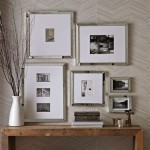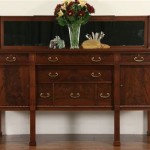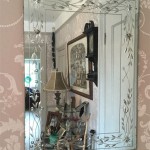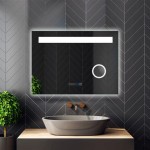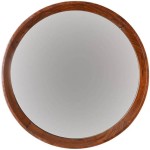Large Wall Mirror Dimensions: A Guide to Choosing the Right Size
Large wall mirrors serve both functional and decorative purposes in homes and commercial spaces. They can create the illusion of more space, reflect light to brighten a room, and act as striking design elements. However, selecting the right dimensions for a large wall mirror can be challenging. This guide explores the key considerations for choosing the perfect size, including furniture proportions, wall space, and mirror shape.
Considering Furniture Proportions
A crucial factor in determining the ideal dimensions of a large wall mirror is its relationship to nearby furniture. When placed above a console table, fireplace mantel, or sofa, the mirror should complement rather than overwhelm the piece. A general rule of thumb is that the mirror's width should be slightly smaller than the furniture's width, typically between two-thirds and three-quarters. This creates a balanced and harmonious visual appeal. For example, a console table measuring 60 inches wide would ideally be paired with a mirror between 40 and 45 inches wide.
The mirror's height is also important when considering furniture proportions. If placed above a mantelpiece, the mirror should leave sufficient space between its top edge and the ceiling. A space of at least six to eight inches is generally recommended. Similarly, when positioned above a sofa, the mirror should not hang so high that it appears disconnected from the furniture. The bottom edge of the mirror should ideally be a few inches above the sofa's back.
Maximizing Wall Space
The dimensions of the wall itself are paramount when selecting a large wall mirror. A large mirror on a small wall can make the space feel cramped, while a small mirror on a large wall can appear insignificant. Before purchasing a mirror, carefully measure the available wall space, taking into account any architectural features such as windows, doors, or moldings. This allows for visualizing the mirror's impact on the overall room design.
In larger rooms, a substantial mirror can become a focal point, adding depth and character. Consider the surrounding décor and the desired aesthetic when choosing the mirror's size. A minimalist design might benefit from a single, oversized mirror, while a more eclectic space could incorporate a gallery wall of smaller mirrors, creating a dynamic and visually engaging display.
For narrow hallways or smaller rooms, utilizing vertical space can be advantageous. A tall, narrow mirror can create the illusion of height, making the space feel more open and airy. Similarly, in rooms with low ceilings, a horizontal rectangular mirror can visually widen the space.
Exploring Mirror Shapes and Their Impact on Dimensions
Beyond rectangular mirrors, a wide variety of shapes are available, each impacting the perceived size and space within a room. Round or oval mirrors can soften the sharp lines of a room's architecture, adding a touch of elegance and fluidity. These shapes are particularly effective in smaller spaces, as they avoid overwhelming the visual field.
Square mirrors offer a classic and versatile option, working well in both modern and traditional settings. Their symmetrical shape provides a sense of balance and order. When choosing a large square mirror, consider how its dimensions relate to other square or rectangular elements in the room, such as windows, artwork, or furniture.
More unconventional shapes, such as arched, sunburst, or geometric mirrors, can add a unique and artistic touch. These statement pieces can serve as focal points, adding personality and visual interest to a room. When incorporating uniquely shaped mirrors, it's important to carefully consider their scale within the space, ensuring they complement the surrounding décor without overpowering it.
For unusually shaped mirrors, measuring the overall dimensions, including the furthest points in both height and width, is crucial. This helps ensure a proper fit on the wall and allows for accurate visualization of the mirror's size relative to the room and existing furniture. Understanding the specific dimensions of these unique shapes allows for a more informed decision, ensuring the chosen mirror enhances the desired aesthetic.
Choosing the appropriate dimensions for a large wall mirror involves careful consideration of various factors, including the size and shape of the wall, the proportions of nearby furniture, and the overall desired aesthetic. By carefully evaluating these elements, individuals can confidently select a mirror that enhances the beauty and functionality of their space.

How To Measure Your Space For A Large Wall Mirror 2 Steps

Extra Large Wall Mounted Mirror Framed Rectangular By Kristalia Design Luciano Bertoncini

How To Measure Your Space For A Large Wall Mirror 2 Steps

How To Measure Your Space For A Large Wall Mirror 2 Steps

36 In W X 60 H Rectangle Big Wall Mirror For Bathroom Black Modern Mirrors With Aluminum Frame Hangs Em D0102h59r8x The Home Depot

Gold Frame Rectangular Wall Mirror 24x36 Large Decorative Beveled Mi Hamilton Hills

Large Wall Mirror Over Door 30 X 120 Cm Full Length Bedroom Dressing Room

Norfolk Oak Blue Painted Wall Mirror The Co

47 2 Large Long Arch Natural Carved Wood Full Length Wall Mirror Decor Art Living Room Homary

Keonjinn Brushed Gold Wall Mirror 22 X 30 Rectangular Bathroom Brass Metal Frame Modern Vanity Farmhouse Rectangle Square Corner Horizontal Vertical


